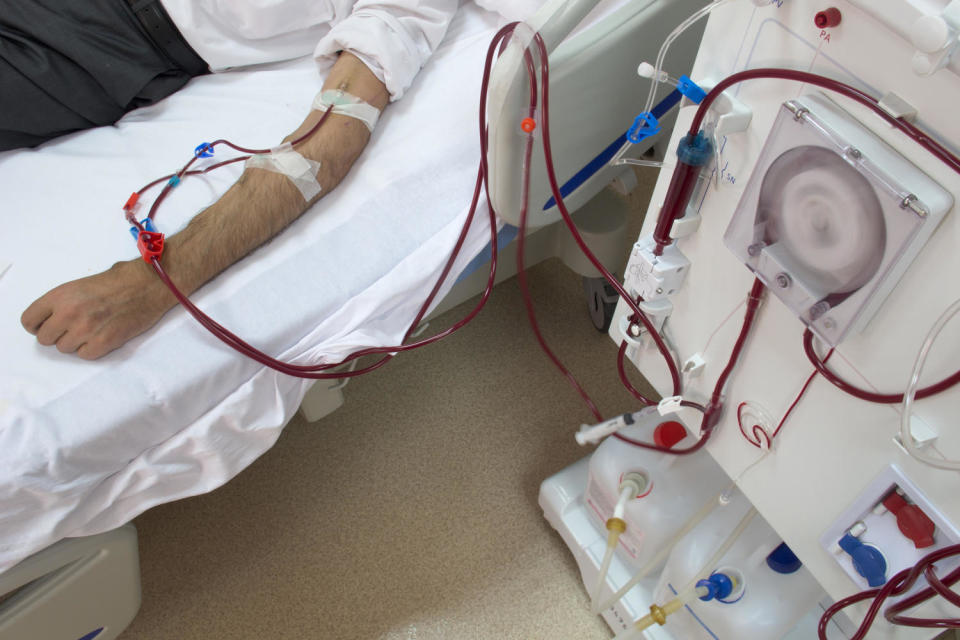New heart syndrome identifies link among obesity, diabetes and kidney disease
As more Americans are being diagnosed with multiple chronic health problems at younger ages, for the first time, the American Heart Association is identifying a new medical condition that reflects the strong links among obesity, diabetes and heart and kidney disease.
According to an advisory released Monday, the goal in recognizing the condition — cardiovascular-kidney-metabolic syndrome, or CKM — is to get earlier diagnosis and treatment for people at high risk of dying from cardiovascular disease.
“Reducing the pipeline of individuals progressing to heart disease is our primary goal,” said the lead author of the advisory and an accompanying statement, Dr. Chiadi E. Ndumele, the director of obesity and cardiometabolic research in the division of cardiology at Johns Hopkins University.

Right now, “we’re seeing the health consequences of all these conditions interacting and leading to earlier presentations with heart disease,” Ndumele said. Naming and describing CKM are “really a paradigm change.”
Increasing evidence shows how metabolic risk factors such as abdominal fat, high blood pressure, high cholesterol and high blood sugar can negatively affect other organs in the body.
Dr. Pam R. Taub, a cardiologist, agreed that the new approach may be a “game changer” in how doctors treat patients.
The development of new medications to treat conditions that are part of the syndrome, such as kidney disease, diabetes and obesity, has resulted in decreases in cardiovascular events and given doctors new insights into the relationship among the different organs, said Taub, a professor of medicine at the UC San Diego School of Medicine.
“It’s been eye-opening,” Taub said. CKM takes into account “what I call organ cross-talk, in which they are interacting with each other very intricately in the body.”
For example, early kidney disease can be detected in a patient’s urine sample. “The reason this is so important is the drugs you can give the patient will prevent them from progressing to chronic kidney disease,” she said.
In general, Taub said, when you look at the organs together, “you can detect disease early and you’re going to prevent bad cardiovascular outcomes, like heart failure, heart attacks and stroke.”
Fortunately, people with the newly defined condition can improve if it’s caught early and treated.
“Several times in my clinical practice I have seen regression after significant lifestyle changes and weight loss,” Ndumele said.
Along with defining the new syndrome, Ndumele and his team devised a system of stages for doctors to identify patients at risk:
Stage 0: There are no risk factors for heart disease.
Stage 1: Someone who is overweight with a lot of abdominal fat or who has prediabetes. People in stage 1 would be advised to follow a healthy lifestyle, with a goal of at least 5% weight loss.
Stage 2: Someone with Type 2 diabetes, high blood pressure, high triglycerides or kidney disease. Treatments could include medications to control blood pressure, blood sugar and cholesterol. Patients might also be prescribed diabetes drugs such as SGLT2 inhibitors, which protect kidney function, and GLP-1 receptor agonists, such as Ozempic or Wegovy, to help control blood sugar and lose weight.
Stage 3: People with metabolic risk factors such as high blood pressure and early cardiovascular disease or kidney disease but who don't have symptoms yet. Treatments would include heart and diabetes medications, as well as testing for narrowing of the arteries.
Stage 4: Someone with diagnosed heart disease, excess body fat, metabolic risk factors or kidney disease. Patients may already have had heart attacks or strokes or may already have developed heart failure. People at this stage would fall into one of two categories: those without kidney failure and those with it.
More than 90% of adults fall on the CKM spectrum, Ndumele estimated, driven mainly by record levels of obesity and Type 2 diabetes in adults and children. The Centers for Disease Control and Prevention estimates that 41.9% of adults and 19.7% of children in the U.S. are obese. More than 37 million adults have diabetes.
The advisory could encourage doctors “to look at a bigger target,” said Dr. Howard Weintraub, the clinical director of the Center for the Prevention of Cardiovascular Disease at NYU Langone Heart in New York.
That may help with identifying and treating patients before conditions have progressed. It may also persuade patients to see obesity as a health risk, Weintraub said.
“It’s bringing obesity and waist circumference back as a focus,” he said. “This got a lot of play 15 or 20 years ago, but then it kind of went away.”
One big reason, Weintraub said, is there were no medications to treat the condition. When a patient came in with a BMI close to 30 and a hint that the risk of diabetes might be rising, doctors were likely to just “pat the patient on the back, tell them to lay off the french fries, get more exercise and then say, ‘See you next year,’” he said.
The new entity, CKM, may get doctors and patients more engaged earlier. “So rather than wait till somebody is already advanced by the time they come to medical attention, we can treat them earlier,” Weintraub said.
Weintraub worries about the cost of the new drugs and that insurance companies may balk at paying for them, especially for people in the early stages.
Ultimately, the best solution is to reach Americans when they are young and healthier, Weintraub said. “We need to keep America’s youth a healthy weight and not let their arteries turn into lead pipes by the time they are in their 30s.”
This article was originally published on NBCNews.com

